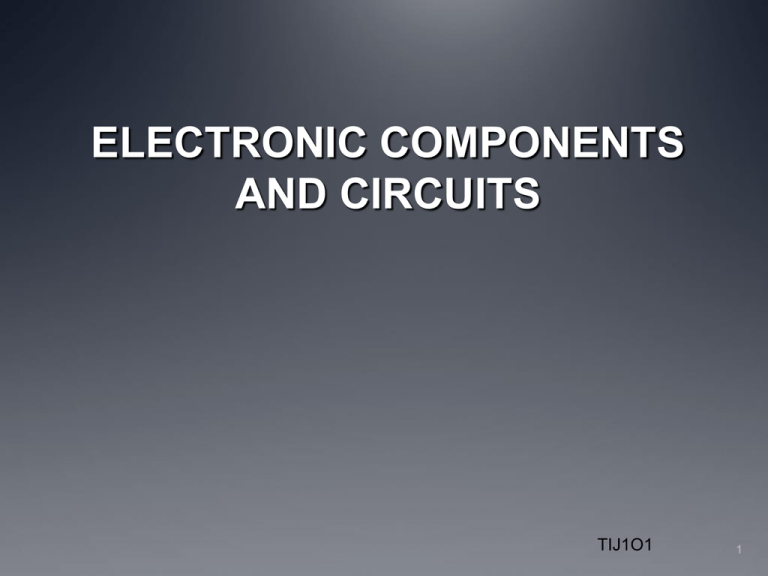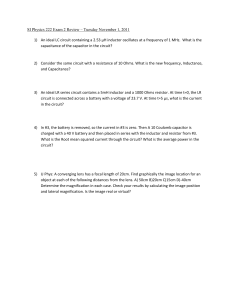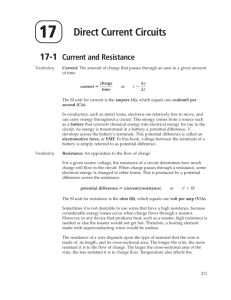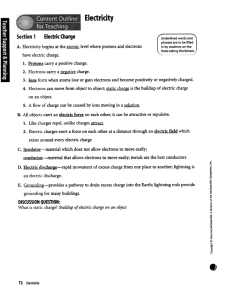File - Mrs Lombardi
advertisement

ELECTRONIC COMPONENTS AND CIRCUITS TIJ1O1 1 Recap: What is an electric current? An electric current is a flow of microscopic particles called electrons flowing through wires and components. + - In which direction does the current flow? from the Negative terminal to the Positive terminal of a battery. 2 simple circuits Here is a simple electric circuit. It has a battery, a lamp and a switch. battery wires switch lamp To make the circuit, these components are connected together with metal connecting wires. 3 simple circuits When the switch is closed, the lamp lights up. This is because there is a continuous path of metal conductor for the electric current to flow around. If there were any breaks in the circuit, the current could not flow. 4 circuit diagram Engineers usually draw electric circuits using symbols; Battery lamp switch wires 5 circuit components In circuit diagrams—also called schematic diagrams- components are represented by the following symbols-here are some examples… capacitor LED battery switch lamp voltmeter transistor resistor diode variable resistor 6 circuit components 7 circuit components WIRE: is a CONDUCTOR which is a material that permits electrons to flow freely from atom to atom and molecule to molecule. Wire is commonly made of the metal copper which carries (conducts) electrical current well. 8 circuit components The wire is covered in plastic called insulation. An INSULATOR is a type of material the impedes or stops the free flow of electrons. Insulators isolate conducting materials from each other. Examples: plastics, paper, rubber, glass and dry air. 9 circuit components WIRE GAUGE: It’s the thickness or diameter of a wire. The greater the gauge, the more electric current it can safely carry. Wire gauge is measured in AWG units. AWG stands for American Wire Gauge. The higher the number, the thinner the wire. 10 circuit components DC VOLTAGE SUPPLY: It can take the form of a battery or an electronic power supply (PSU) like used in computers. PSU’s convert AC (Alternating Current) into low voltage DC (Direct Current) more useful for electronics. You will be using a 9 Volt battery for your project. A battery is a chemical-based power storage device that produces Direct Current—current that flows in one direction only. 11 circuit components BATTERY SNAP: It connects to the POSITIVE and NEGATIVE terminals of the 9 Volt battery to be used in your Flashing LED Project. You must be certain that the polarity of the battery snap and battery match—the connectors on the snap only fit one way. Remember, BLACK wires connect to the NEGATIVE (-) terminal and RED wires connect to the POSITIVE (+) terminal. 12 circuit components RESISTOR: A resistor is a component that develops a voltage drop when supplied with a current—it resists or impedes the flow of electrons. The amount of resistance is measured in OHMs Ω. Remember Ohm’s Law: R=V/I Resistors do not have polarity. You can orient them in either direction. 13 Resistor Colour Code BLACK BROWN RED ORANGE YELLOW GREEN BLUE VIOLET GRAY WHITE GOLD SILVER 0 1 2 3 4 5 6 7 8 9 +/- 5% +/- 10% 14 circuit components CAPACITOR: A capacitor is a storage container for an electric charge. While the capacitor is charging up, current flows. The current will stop flowing when the capacitor has fully charged. Capacitance is measured in units called Farads. Capacitors DO have polarity. The longer lead is Positive and the shorter lead is Negative. 15 circuit components A SEMICONDUCTOR is a material in-between conductors and insulators in their ability to allow the free flow of electrons. SEMICONDUCTORS are the foundation of modern electronics, including radios, TV’s, computers, smart phones, etc. Some examples of electronic components that are made from semiconductor material, usually silicon, are transistors, diodes, LED’s (Light Emitting Diode) and photovoltaic (solar) cells. 16 circuit components TRANSISTOR: A transistor is used either for amplifying, or as a switch. You will be using it as a switch. Computer CPU’s have millions of microscopic transistors embedded in them to perform logic calculations. Transistors have three leads: Emitter, Base and Collector, and must be connected correctly for the circuit to function. 17 circuit components LED (Light Emitting Diode): An LED is a semiconductor light source. They are illuminated by the movement of electrons in a semiconductor material and last much longer than incandescent light bulbs and use much less energy. They also produce very little heat. LED’s have polarity: The longer lead is the positive and is called the Anode. The Shorter lead is the negative and is called the cathode 18 circuit components The Asus P4T motherboard uses many of the same kind of electronic components that you will be using in your LED Flasher Circuit Project 19 circuit components The LED Flasher Project uses: battery (1), switch (1), wires, resistors (4), Capacitors (2), transistors (2), LED’s (2) 20 Circuit Schematic Diagram – LED Flasher 21






